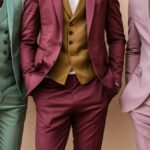Is your black business suit still the right choice for today’s office—or is it too formal for modern dress codes?
Workplace style has changed. Offices are blending professionalism with comfort, and dress codes are more flexible than ever. But where does that leave the classic black suit?
Whether you’re heading to a client meeting or just want to look sharp on a regular workday, this guide will show you how to wear your black suit in a way that feels current, stylish, and appropriate. Learn how to dress it up, dress it down, and make it work year-round.
Scroll down for essential tips, outfit formulas, seasonal advice, and FAQs—so you’ll always know when and how to make your black business suit look right for the office today.
Here’s what you’ll learn:
- Modern Suit Options: The different types of suits—from classic two-piece to sleek slim fit—and how to wear them today.
- Black Suit in Today’s Office: When a black suit is still professional and how to dress it down for less formal settings.
- What Business Casual Really Means: How the dress code has evolved and what men actually wear to work now.
- Essential Wardrobe Pieces: Must-have business casual staples like button-downs, chinos, and loafers.
- How to Dress for the Seasons: Outfit tips for staying sharp year-round—spring through winter.
- Quick Outfit Ideas and FAQs: Ready-made looks, plus answers to common questions about suits, ties, and dressing for work.
What Is a Suit?
A suit is a matching set of clothing—usually a jacket and trousers—made from the same fabric. It’s designed for formal or professional occasions and gives a clean, polished appearance. Suits vary in style, fit, and color to match different events, seasons, and preferences.
Types of Suit
Two-Piece Suit
The two-piece suit includes a matching jacket and trousers. It’s the most common suit style and works for everything from job interviews to weddings. Its simplicity makes it a go-to option for men who want a clean and classic look.
Three-Piece Suit
A three-piece suit adds a matching vest (waistcoat) to the jacket and trousers. It offers a more formal and polished appearance. Great for weddings, business events, or when you want to look extra sharp.
Single-Breasted Suit
This style features a jacket with one column of buttons and a narrow overlap. It’s a timeless and versatile choice, suitable for both formal and casual settings depending on the fabric and color.
Double-Breasted Suit
With two columns of buttons and a broader front, the double-breasted suit feels more structured and formal. It’s often chosen for high-end events or when making a bold, confident impression.
Slim Fit Suit
Designed to closely follow the shape of the body, slim fit suits offer a sleek and modern silhouette. Best for leaner body types, they’re popular among younger wearers and trend-driven dressers.
Classic Fit Suit
This suit provides a looser, more comfortable cut with extra room in the chest and legs. It’s ideal for traditional or conservative settings and suits all body types.
Modern Fit Suit
A blend of slim and classic, modern fit suits offer a tailored look with a bit more room. They’re perfect for men who want a contemporary feel without sacrificing comfort.
What Is Business Casual for Men?
Business casual for men is a dress code that blends professional style with relaxed comfort. It usually includes items like dress pants or chinos, a button-up or polo shirt, and closed-toe shoes like loafers or brogues. Jackets and ties are optional, but the overall look should stay neat, polished, and workplace-appropriate.
👔 The Evolution of Business Casual
Business casual has changed a lot over the years. What started as a relaxed version of formal office wear is now a flexible, style-driven approach to dressing for work. Here’s how it evolved:
📅 The 1980s: Casual Fridays Begin
Tech companies in Silicon Valley started “Casual Fridays” to let employees feel more relaxed. Slacks and polo shirts became common alternatives to suits. It was still neat, but less rigid.
👞 The 1990s: Khakis and Collars
Khaki pants, button-down shirts, and loafers became the business casual norm. Suits were reserved for top executives or formal days. The idea was comfort without looking sloppy.
🧥 The 2000s: Mixing High and Low
Workers began mixing blazers with jeans or dress shoes with T-shirts. Style started to matter more than following strict dress codes. Offices began loosening up on “professional” boundaries.
💻 The 2010s: Influence of Tech and Remote Work
Tech giants and startups embraced hoodies, sneakers, and denim at work. Remote work blurred the lines between office wear and home clothes. Comfort became as important as looking polished.
🧑💼 Today: Modern, Flexible Business Casual
Now, business casual is about looking clean, smart, and confident—whether in chinos, a knit polo, or a sleek suit vest. It depends on your industry, role, and culture. Personal style and versatility lead the way.
👔 Styling a Business Casual Outfit: Must-Have Items
Business casual is all about balance—clean, polished, and comfortable. You don’t need a full suit, but you still want to look put-together. These are the core items every man should own:
👕 Crisp Button-Down Shirt
A classic white or light blue shirt works for any business casual setting. Roll up the sleeves for a relaxed vibe or keep them down for more polish. Make sure it’s always clean and wrinkle-free.
🧥 Unstructured Blazer or Sport Coat
A lightweight blazer adds sharpness without feeling too formal. Stick to neutral colors like navy, grey, or olive. It’s easy to throw on and instantly upgrades your look.
👖 Well-Fitted Chinos or Dress Pants
Chinos offer comfort with a clean, tailored shape. Choose slim or straight fits in neutral tones like beige, navy, or charcoal. Avoid overly casual fabrics like denim unless your office allows it.
👞 Smart Shoes
Loafers, brogues, or clean leather sneakers (if allowed) strike the right balance. Brown or black leather shoes are the safest picks. Make sure they’re polished and match your belt.
⌚ Minimal Accessories
Keep it simple: a watch, belt, and maybe a pocket square. Avoid anything too flashy or distracting. Let your clothes do the talking.
🌦️ Seasonal Business Casual Tips
Your outfit should match the weather. Here’s how to stay sharp year-round:
🌸 Spring
Go for light fabrics like cotton or linen. Soft colors—light grey, blue, tan—feel fresh. Try an unlined blazer and loafers or clean sneakers.
☀️ Summer
Skip the tie and wear breathable shirts. Short sleeves or lightweight long sleeves work best. Stick to chinos or linen pants—no heavy jackets.
🍂 Fall
Layer with sweaters or cardigans. Choose deeper tones like olive, burgundy, or navy. Heavier fabrics like wool or flannel add warmth.
❄️ Winter
Wear thick blazers and wool trousers. Swap shirts for turtlenecks. Add a clean overcoat and stick to dark, neutral tones.
FAQ: Business Casual & Black Suits
Are black suits appropriate for business?
Yes, but avoid shiny fabric. Stick to wool or matte finishes.
How to wear a black suit for business?
- Use a light shirt to soften the look.
- Add a colored tie or skip the tie entirely.
- Break it up by wearing just the jacket with chinos.
How many business suits should you own?
Start with 2–3: navy, grey, and black. Rotate them weekly.
Are black suits professional?
Yes, especially in more traditional industries. Keep the fit modern and simple.
Suit without tie business casual—can you do it?
Absolutely. Just unbutton the top shirt button and skip the pocket square.
How to wear a black suit casually?
- Ditch the tie.
- Pair with a T-shirt or polo.
- Use sneakers or loafers instead of dress shoes.
Formal suit ideas?
- Stick to dark colors: navy, charcoal, or black.
- Add a tie, polished shoes, and maybe a pocket square.
Final Thoughts:
The black business suit men’s style is not dead—it just needs a modern touch. It’s still professional in many workplaces but can be too formal in some modern, casual offices. The key is knowing your company’s dress code and making the suit work for you.




Leave a Reply